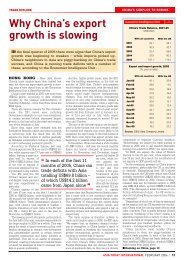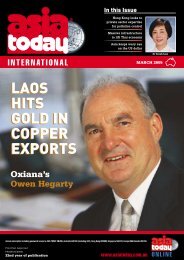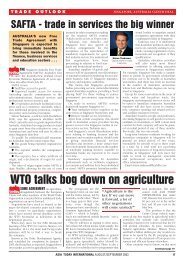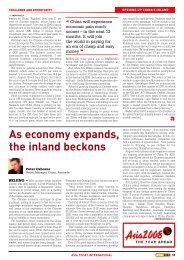download - Asia Today International
download - Asia Today International
download - Asia Today International
Create successful ePaper yourself
Turn your PDF publications into a flip-book with our unique Google optimized e-Paper software.
RESHAPING SHENZHEN<br />
g FROM PAGE 7<br />
to promote Shenzhen at seminars in Sydney<br />
and Brisbane in early September. Members of<br />
the delegation will be searching out business<br />
opportunities in Australia for Shenzhen-based<br />
companies, and also encouraging Australian<br />
businesses to either start up operations in<br />
Shenzhen’s high-tech sector, or to consider part<br />
or full relocation to Shenzhen. Special recruitment<br />
fairs for skilled workers able to contribute<br />
to the development of Shenzhen’s emerging industry<br />
sectors are also planned.<br />
More than 40 Shenzhen companies will be<br />
seeking to promote R&D co-operation with<br />
Australian firms, and to recruit talented students<br />
and high-tech specialists and teams to<br />
work in Shenzhen. They will also seek to establish<br />
closer links with universities and higher<br />
education facilities, which in Australia form the<br />
core of new research in emerging industries.<br />
To attract and retain skilled talent from overseas,<br />
Shenzhen has developed what it calls its<br />
Peacock Programme. In Chinese idiom, the<br />
peacock flies to the Southeast of a country to<br />
seek jobs and opportunity. Shenzhen is at the<br />
Southern tip of China.<br />
The Peacock Programme offers a range of incentives<br />
for entrepreneurs, including rental<br />
subsidies, R&D funding, research transfer<br />
funding, innovation team funding and matching<br />
subsidies. Says Shorf Fu: We want to encourage<br />
team leaders and others with skills and<br />
talent to come to Shenzhen to work in our<br />
emerging industries. We also want to introduce<br />
Australian companies involved in R&D and<br />
new technology to Shenzhen enterprises, and<br />
to encourage Australian companies to establish<br />
partnerships in Shenzhen to develop new ideas<br />
through to commercialisation. “<br />
There are many start-up Australian companies<br />
with great ideas and sound R&D<br />
capability, he says. “The competitive strength<br />
of Australia in R&D is not in question. But Australia<br />
often does not have enough funds available<br />
to take innovation to the next stage – Shenzhen<br />
does. Shenzhen can be fully involved in<br />
the industrialisation or commercialisation of<br />
R&D in any of the six emerging industries.”<br />
In Shenzhen today, many of the larger companies<br />
commit up to 50 per cent of their staff to<br />
research and development of new products and<br />
applications in the IT and new industry sectors.<br />
Shenzhen City itself each year commits 3.5 per<br />
cent of total GDP to help fund new technology<br />
and innovative start-up industries.<br />
Says Fu: “In Australia, we want to showcase<br />
Shenzhen as a city of innovation for business, a<br />
city of entrepreneurs that have thrown up a lot<br />
of opportunities and networks for emerging industries<br />
over the past decade.<br />
“In China, Shenzhen is the one city that has<br />
given birth to a number of multinational companies<br />
– last year, for example, Huawei, which<br />
is headquartered in Shenzhen, became the<br />
world’s leading telecommunications equipment<br />
and service provider.<br />
“But it is not just local Shenzhen SMEs that<br />
have grown up into international companies;<br />
foreign-invested companies have been able to<br />
do that as well. For Australian SME and startup<br />
companies in emerging industries, there are<br />
immense opportunities to develop and expand<br />
out of Shenzhen.”<br />
www.setro.org.au<br />
email shorf.fu@setro.org.au<br />
COVER REPORT<br />
A City of Innovation, a<br />
City of Entrepreneurs<br />
FREED of many constraints on business operating elsewhere in China,<br />
Shenzhen has given birth to some of China’s most successful global corporations<br />
– and some of its wealthiest people . . .<br />
SHENZHEN brands itself as the City of<br />
Innovation. A migrant city – only 2.7 million of<br />
Shenzhen’s 10.5 million people have permanent<br />
residency, only two million were born there – it<br />
has become a magnet for China’s young entrepreneurs.<br />
Freed of many of the constraints on business<br />
operating elsewhere in China, these entrepreneurs<br />
have given birth to some of China’s largest<br />
and most successful global corporations<br />
and, in the process, created enormous wealth.<br />
Like BYD founder, Wang Chuanfu, born into a<br />
poor farming family, raised by an elder brother<br />
and sister after his parents died, and now<br />
ranked among the wealthiest of all Chinese<br />
people.<br />
Wang studied chemistry, graduating in 1990<br />
with a Masters degree, then working as a Government<br />
researcher until 1995 when he set up a<br />
business in Shenzhen. BYD is an acronym from<br />
a translation of the company’s Chinese name,<br />
‘Build Your Dreams’.<br />
Wang set out to build his dream through the<br />
manufacture of rechargeable batteries, in direct<br />
competition in the Chinese domestic market<br />
against Japanese imports.<br />
Within 10 years, BYD held more than half of<br />
the total world market for mobile phone batteries,<br />
and along the way (in 2002) listed on the<br />
Hong Kong Stock Exchange.<br />
Also in 2002, BYD bought the Tsinchuan Automobile<br />
Company, which, by 2010 had become<br />
China’s sixth-largest car manufacturer.<br />
Having gone from just 20 employees in the<br />
earliest days to more than 150,000 spread<br />
across 10 industrial parks in China, BYD is now<br />
the world’s largest supplier of rechargeable batteries,<br />
with a firm focus on information technology,<br />
the car sector (it plans to manufacture<br />
China’s first commercially-viable electric car)<br />
and new energy. It has sales and marketing operations<br />
in the United States, Europe, Japan,<br />
South Korea, Taiwan and Hong Kong.<br />
Also among China’s wealthiest are Li Li and<br />
his wife, Li Tan, who jointly own 70 per cent of<br />
Shenzhen Hepalink Pharmaceuticals, which<br />
manufactures the blood-thinning agent Heparin<br />
and related products for world markets, distributed<br />
essentially through the global pharmaceutical<br />
majors.<br />
The couple, who first met while studying<br />
chemistry at Sichuan University, keep a very<br />
low public profile.<br />
They originally held 80 per cent of Hepalink,<br />
but sold 10 per cent in 2010 in an IPO on the<br />
Shenzhen Exchange, which valued the company<br />
then at US$6.2 billion. At RMB148 per share, the<br />
Hepalink IPO price was the most expensive ever<br />
offered in China.<br />
Li Li worked with a meat company in<br />
Chengdu, then with a biotech company in<br />
Chongqing, before forming Hepalink in Shenzhen<br />
in 1998. It is the only Chinese company accredited<br />
by the US Food and Drugs Administration<br />
to export the active ingredients of Heparin,<br />
which is derives from pig intestines.<br />
The list of other corporate successes born<br />
and still headquartered in Shenzhen is impressive<br />
. . .<br />
n Huawei, now possibly the world’s largest<br />
telecommunications networking, equipment<br />
and services provider, which saw 2011 profit<br />
BYD’s Wang Chuanfu – Made a fortune in rechargeable batteries, now planning<br />
China’s first commercially-viable electric car.<br />
numbers increased by 30 per cent to US$3.64<br />
billion.<br />
Founded in Shenzhen in 1987 by Ren Zhengfai<br />
with capital of just RMB21,000, Huawei is<br />
still privately owned by its employees – 46 per<br />
cent of whom are engaged in R&D.<br />
Huawei has 17 global R&D centres, and 10<br />
g CONTINUED PAGE 9<br />
8 | AUGUST/SEPTEMBER 2012 ASIA TODAY INTERNATIONAL

















